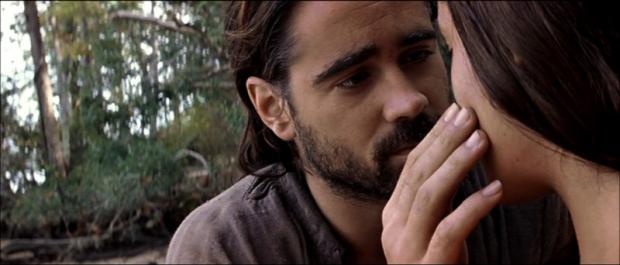THE NEW WORLD (Terrence Malick, 2005)
Museum of the Moving Image
35th Ave. at 36th St., Astoria
Sunday, May 15, free with museum admission of $10, 5:00
Series runs May 13-15
718-777-6800
www.movingimage.us
 Iconoclastic American auteur Terrence Malick has directed a mere four films in his forty-year career, each a gem in its own way — 1973’s Badlands, 1978’s Days of Heaven, 1998’s The Thin Red Line, and 2005’s The New World. With the imminent release of his latest, The Tree of Life, expected later this year — as with The New World, it’s gone through a number of casting, editing, and distribution dilemmas — the Museum of the Moving Image is showing all four of Malick’s feature-length works May 13-15, with many of the screenings introduced by film critic Matt Zoller Seitz. The necessarily brief series, simply titled “Terrence Malick,” is anchored by The New World, scheduled for Sunday at five o’clock. Spectacularly photographed by cinematographer Emanuel Luzbeki, The New World reimagines the story of Captain John Smith (Colin Farrell) and Pocahontas (Q’orianka Kilcher) as an epic tale of unrequited desire, a fiercely passionate, if not completely accurate, love story for the ages. In 1607 , a crew led by Captain Christopher Newport (Christopher Plummer) has landed in what will come to be known as Jamestown. The disgraced Smith, who was nearly hanged for mutiny, is ordered to meet with “the naturals” in order to develop a favorable relationship. But Smith falls deeply for Chief Powhatan’s (August Schellenberg) beautiful young daughter (Q’orianka Kilcher), who shares his feelings, leading to a dangerous love that threatens to leave death and destruction in its wake. Large stretches of the film feature no dialogue, instead consisting of gorgeously framed shots with gentle, poetic narration from Smith, Pocahontas, and, later, John Rolfe (Christian Bale). The scenes between Farrell and Kilcher nearly ignite the screen, their eyes burning into each other. Malick and Luzbeki focus on lush, rolling fields and rushing rivers that are more than just beautiful scenery; the gorgeous landscape of this new world is filled with promise, with hope, even though we know what eventually, tragically happens. The film bogs down considerably when Smith’s place in the newly named Rebecca’s life is taken over by Rolfe, but it all builds to a heart-wrenching conclusion.
Iconoclastic American auteur Terrence Malick has directed a mere four films in his forty-year career, each a gem in its own way — 1973’s Badlands, 1978’s Days of Heaven, 1998’s The Thin Red Line, and 2005’s The New World. With the imminent release of his latest, The Tree of Life, expected later this year — as with The New World, it’s gone through a number of casting, editing, and distribution dilemmas — the Museum of the Moving Image is showing all four of Malick’s feature-length works May 13-15, with many of the screenings introduced by film critic Matt Zoller Seitz. The necessarily brief series, simply titled “Terrence Malick,” is anchored by The New World, scheduled for Sunday at five o’clock. Spectacularly photographed by cinematographer Emanuel Luzbeki, The New World reimagines the story of Captain John Smith (Colin Farrell) and Pocahontas (Q’orianka Kilcher) as an epic tale of unrequited desire, a fiercely passionate, if not completely accurate, love story for the ages. In 1607 , a crew led by Captain Christopher Newport (Christopher Plummer) has landed in what will come to be known as Jamestown. The disgraced Smith, who was nearly hanged for mutiny, is ordered to meet with “the naturals” in order to develop a favorable relationship. But Smith falls deeply for Chief Powhatan’s (August Schellenberg) beautiful young daughter (Q’orianka Kilcher), who shares his feelings, leading to a dangerous love that threatens to leave death and destruction in its wake. Large stretches of the film feature no dialogue, instead consisting of gorgeously framed shots with gentle, poetic narration from Smith, Pocahontas, and, later, John Rolfe (Christian Bale). The scenes between Farrell and Kilcher nearly ignite the screen, their eyes burning into each other. Malick and Luzbeki focus on lush, rolling fields and rushing rivers that are more than just beautiful scenery; the gorgeous landscape of this new world is filled with promise, with hope, even though we know what eventually, tragically happens. The film bogs down considerably when Smith’s place in the newly named Rebecca’s life is taken over by Rolfe, but it all builds to a heart-wrenching conclusion.
